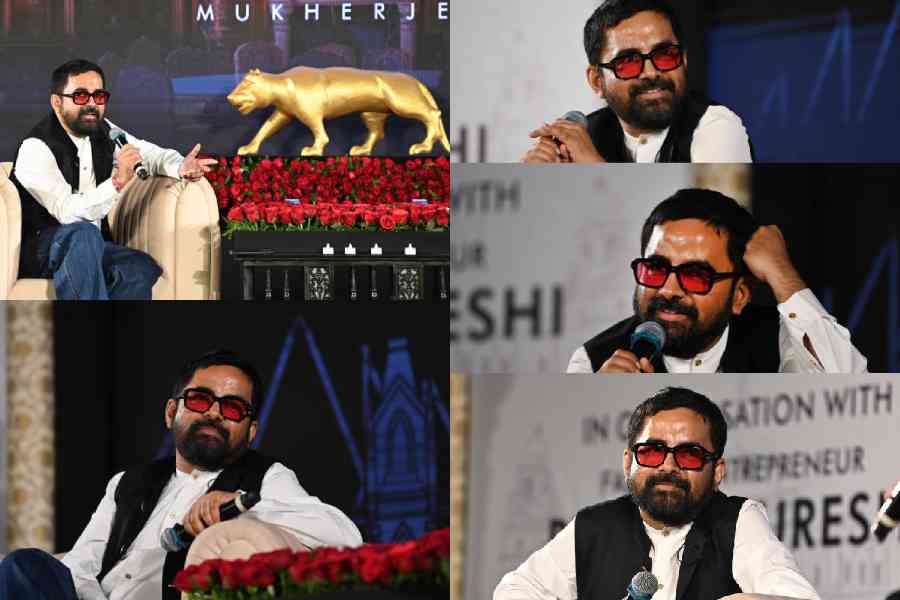Growing up middle-class in Bengal
When you grow up middle-class in India, you don’t have a lot of options. The only thing you can have is good education and use that education to build a career. What happens when a middle-class person is aspiring for business, for a lot of us, what becomes much more important is our idealism or cultural idealism more than money. When you grow with little and bound with education, your mind grows stronger and it becomes a fertile ground to grow or expand the horizons of your mind in the world. That is something I always cherished because there is one way of growing up middle-class in the world and one way of growing up middle-class in Bengal. When you grow up middle-class in Bengal, your entire life and identity, who you are and who you become is crafted on what you can do with your education and it gives you real and solid values. Your parents only tell you that chasing the right dreams and doing the right thing are far more important than making money because then you will have great value in the world and not just make money.
Translating dreams into reality
What I dream of is exuberance and excellence. Now that I have the privilege of travelling all over the world and meeting people from all over the world, I realise that the West has a lot of posturing. It tells us a lot of stories but their backyards are empty, and in India, we have full backyards but never told stories. I think we are a little shy of talking about ourselves. When you go to North Calcutta, you look at the houses and they are falling apart, you think that people don’t have rent to pay but if you go inside, you will see beautiful carpets, old chandeliers and beautiful paintings. What I love about Calcutta as a city is what we collect and what we value is never measured by money, it is always measured by sentiment. When I was growing up, I had very little but I had very educated parents — my father was a chemical engineer and my mother was a painter — and they taught us that if we dream and have sensitivity, the world is ours.
Today, I think, I am privileged to be born in this city. I have travelled all over the world, but there’s no other city that can replace this city. While every other city is smart, Calcutta is a wise city. They call us backward and say we don’t have exposure, but what they haven’t understood is, when the entire world is modernised and everybody is being influenced by the age of influence and AI now, Calcutta is going to become a very expensive city in terms of its cultural heritage because our backwardness has probably helped us preserve and nurture our culture.
Taking Calcutta international
Calcutta helped me to take the glory forward because if I was not born in the city, I don’t think I would have these resources. It is only immense gratitude that I have for this city. You don’t realise this when you are growing up or when you are in your mid-20s and 30s, but more so when you are in your 40s, and I am 51 now, when I reflect back, I thank God that I was born in this city. There are many here who made me who I am. Nilu (Nilangi) Parekh was my first customer, for whom I made a sari. Sangeeta (Kejriwal) and Purnima (Chawla) who put me in my first ever store, Preeti and Sanjeev Goenka were the first ones to get me a professional show…. All the women by believing in me, by wearing my clothes, by helping me grow my business, they have given me the ways to take India and Calcutta international.
Moving away from bridal fashion
We are now moving away from bridal and it is not going to be our biggest business. When a slew of these weddings happened in India, including the big Bollywood weddings and the big industrial weddings, everybody said that there is going to be a reinvention of bridalwear in this country and weddings are going to be more and more opulent but that is not the case any more. Today, you see there are other politics at play. There was a time, when in India you established a social hierarchy with the power of money. But for the younger generation of this country, social hierarchy is being established by purpose and money has no role to play. So, I have a lot of girls who come to my store, who come from very privileged and rich backgrounds.
Firstly, these girls don’t even come with their chacha, chachi, nana, nani or parents. Sometimes she comes with a boyfriend, sometimes maybe a girlfriend. She comes in wearing jeans and a T-shirt and she swipes that American Express card, and says that she can’t come for fittings because she has a board meeting. If it fits it fits, if it doesn’t fit, her tailor will do something about it. So, there are no trials, no bridezillas because they are very busy in their businesses. Why should business be the privilege of a man? It should be the privilege of a woman. The world has moved on so much that we are discussing maternity leave for men. Why should women have to spend six months sitting at home nursing a child? The man should do it too. Maybe she has a bigger job and is a higher earner in the family, so the husband can change nappies. Why should she have to do it?
When you have this kind of cultural dynamic in the country that is slowly evolving and becoming very very modern, you will take up your heritage with you and the heritage becomes archival. There’s no need for that heritage to be a burden. Heritage can be relevant if it becomes dynamic. For girls and boys today, firstly, there is no gender inequality anymore because girls and boys, school children, are being raised by parents to discuss things like pronouns. Anyone who has grandchildren here would know that they speak a language that we don’t know. They are smarter. As society becomes more smart and confident, and a woman has more agency, a lot of these women will say no if you want to do a 10,000-people wedding. I think that is the true evolution.
If society decides to change for better and if evolution starts taking place, we as individual people have no power to change. But a lot of new businesses will evolve. I think the food business, travel business and hospitality will grow. People will start watching theatre again, parties will come back again. What had happened in India was we had only one place to spend money and demonstrate our culture and that was only weddings. And in many cases, it created a toxic environment for men and women who were getting married. I think we as Indians are very celebratory, we are very proud of our culture but weddings cannot be the only way to express it. There are many other things; I think it is already happening. There is tourism. There are many people who I meet at the airport going for tea tasting or wine tasting somewhere. The good thing is that fashion will come back. When the parties are back, fashion will come back.
The Indian customer
Most of the customers who come back to me come for the same thing over and over again. If you look at the Indian customer, they are very practical and pragmatic. They are probably the smartest customers in the world. Many of you will agree that when you find a perfect blouse sleeve length, you will probably stay with it for 20 years. Once you find a silhouette that is good for you, it will stay with you for 20 years. For the longest time, fashion has made money by feeding on people’s insecurities. It constantly tells them that they are not good enough. The Indian customers know that they are not an idiot and they don’t need to belong to that club. And I also say that the only way to be iconic is through repetition. If you look at all the women, who are the biggest style icons in the world, whether it is Madonna, Rekhaji, our own Usha Uthup — they have all been style icons because they have worn the same look over and over again. What fashion does is fashion makes you one of many. It tells you a lie by saying that I am going to give you a unique identity but what it does is it homogenises you. You buy one dress, 1,500 people are wearing the same dress. You buy one jacket from Chanel, 1,000 people are wearing the same thing. How does it create your identity? Identity is never created by a brand but by a consumer. Because the consumer says this is what I like and this is what I wear.
And today, I don’t have to do another show for the next 20 years of my life because the consumer who comes to a Sabya store doesn’t even need my Instagram or my marketing. They know exactly what they want to buy and they are very happy buying the same thing over and over again. Because it is their identity that they have found with the brand and not what we have created for them.
The 25th anniversary show
The show was to set a lot of biases right. We had a lot of international journalists, very important managing directors from some of the most important luxury houses. We had a lot of top customers from all over the world. India doesn’t have one narrative. India is not only about snakes and peacocks and snake charmers or kings and queens or Bollywood. This is a country which has IT, medicine, performing arts and it is very cultural and very sophisticated. And somewhere down the line, in the age of influence, when certain sections of India get precedence over others that do not shout from their rooftops, this is what people believe they are doing. I wanted to set it right once and for all by saying don’t put India in a corner because you don’t even understand the country. So, when a lot of people came to see the show, they were very shocked that this could exist in India or this could be so sophisticated or so exuberant. There are luxury brands all over the world trying to posture. But India doesn’t even need posturing because there’s so much happening in this country and I am a very proud Calcuttan and that’s why Calcutta was on the map of that show. And I am also a very proud, almost arrogant, Indian.
If India starts believing in itself, we will have a very strong stand in the world. When a country that has been overlooked for a very long time and then it starts rising and we start suddenly feeling a sense of nationalism, it is an unstoppable country. And that’s the nationalism I wanted to kind of put out to a lot of people watching the show. I come from a middle-class family. I had no godfathers. So people are saying if a young child, sitting in one corner of India, can go to the top, with just hard work and idealism, so can I. At least people find hope. That is what I wanted to instill in people.
Minimalist personal style vs exuberant design language
This is the person I am and that’s the job that I do. When I come back home and wear my T-shirts and pyjamas, I become Sabyasachi the man rather than Sabyasachi the designer. Secondly, I grew up nurtured by two very exceptional women — my grandmothers. One taught me the power of minimalism and the other taught me the possibility that maximalism could give. And I think, somewhere down the line, I enjoyed both.
You always do great businesses in detachment. If you become the business then you will never have an opportunity to have a view of what the business is. I am glad that I have a very objective minimalism and a very subjective maximalism approach. So, I make sure that both of these don’t cross each other’s lines. There are two things — you are either an artist or a businessman. I am always a businessman first. I do the art of business but it is business at the end of the day.
The keen observer
I think my biggest strength is that I am a society watcher. You have to understand the society before anything else because that makes you an innovator. Every other job that I do at some point or the other can be replicated by someone in the brand but the only thing that probably I can do alone and I am not being able to find someone who can match up is I understand the evolution of society before society changes. That is what keeps us ahead.
Legacy and succession plan
I am not a selfish entrepreneur. I don’t think Sabyasachi belongs to me anymore. It belongs to the people of the country and it belongs to Calcutta. So, when I was giving my business to Kumar Mangalam Birla, I gave him 51 per cent and the whole country was in shock. It was not a post-Covid panic sale because my company was very profitable. It had a lot of cash reserves. But I was very clear about one thing, I don’t have children. Even if I had children, I would never give the business to them if they were not meant for it because I don’t believe in nepotism.
I believe that businesses should be given to people who are capable of running businesses. I wanted to corporatise Sabyasachi, and I realised this in the last few years.
When I travel and meet people, the narrative has changed. When I used to do Band Baajaa Bride, people used to say, ‘You are such a nice man, you stand so much for feminism, I want my daughter to wear your lehnga.’ After I started meeting these big celebrities, Bollywood weddings, people said, ‘Priyanka looked so nice, Deepika looked so nice or Katrina looked so nice, so I want my daughter to wear your lehnga.’ But today, the only thing that people say is that I make them proud. They don’t even speak about fashion anymore. I had to step back and think about it because that’s a very big responsibility thrust on my shoulder and I don’t even know if I can handle that responsibility. And I wonder what did I do? I am not an engineer, I don’t build bridges that will last for a lifetime. Let’s face the fact that I am a designer, and in India, designers get a lot of undue importance for doing nothing! And then I start thinking about why this is happening. And I am like we have never backed down in terms of integrity of a brand. Sabyasachi never went on a discount, we never will. We don’t customise for anybody. It could be the most powerful person in the country. If my clothes are not good enough for you to wear, don’t wear them.
We have just launched our art foundation and we have a very simple mandate — we are never going to do commissioned art because when you are doing commissioned art you are pandering to the hubris of the person who is buying and diminishing the artist. Art should always have a higher value than money.
Whenever we do international collaborations, I give them a really hard time. When H&M came to me for the first time, I had many conditions before I said yes to them. Condition number one was that this would be a global collaboration. Two was it had to have a significant amount of Indian craft in it, whether it was digitised or not, it had to be visually Indian. Thirdly, I said, 60 per cent of the products had to be made in India because we have to create jobs. I am not going to allow a foreign company to use me to have access to my country and not create jobs in my country. The fourth thing, which was a dealbreaker, was that we have to have a sari. And H&M said, ‘But we are an international company, we have western clothes and we cannot have a sari.’ I said, you think about it. You do a sari, I sign on the dotted line, you don’t do a sari, I don’t. I said that to come to a country where you are feeding people international designs and to take away people’s cultural identity away, I am not going to allow you. So, we have salwar kameezes, kaftans and a sari. This is the first time that H&M has done one.
When I was doing my collaboration with L’Oreal Paris, I remember telling them it is a collaboration of equals and you have to make sure that Aishwarya Rai (Bachchan) wears a sari in front of the Eiffel Tower because the Eiffel Tower is Paris and the sari is India. And at this point, they were like ‘our international brand ambassadors don’t wear saris’. I said you want to enter India through my shoulders, you have to do what I tell you to do. I didn’t back out. India has to fight for their rights. When I do shows internationally with big retailers, I tell them that I need to have the same place as a Chanel and a Dior. I am not going to give you a billion dollars of sales through my Indian consumers and then you put me on the third floor, it is not acceptable to me. Every collaboration has to be respected from both parties and I think that is what India has forgotten to do.
When I do business, I don’t negotiate on behalf of Sabyasachi, I negotiate on behalf of the country. Every time I break a ceiling, I get an opportunity to say fight for your rights and they will give it to you. So, when I was selling my company to Kumar, I said this company does not belong to me, doesn’t belong to you, it belongs to the country. You have a great corporation and you have been a very silent partner. Together we should build a brand that will stay beyond our lifetimes. That is the reason I sold.
Today, fashion is in the biggest crisis globally. Everybody is playing musical chairs. Creative directors are moving from one company to the other, Valentino has started looking like Gucci because Jacopo Venturini took over. CEOs are moving and are taking one business idea to another company. So, fashion will really belong to companies where the owner of the company is the creative director of the company. And the few left, say Gucci or Prada or Armani or Ralph Lauren are all very old and you cannot transition the company when you are that old and the world is becoming so young. I am going to spend the next 20 years nurturing the brand. I always say, who gives birth is not the parent, who raises the child is the parent. And I want the company to be raised by every Indian. And I am sure in the next four to five years, we will be able to give equity to every Indian who believes in the brand. To create something that we all have ownership of, I don’t think I am the owner at all.










